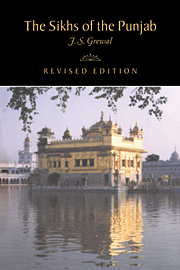Book contents
- Frontmatter
- Introduction
- 1 The Turko-Afghan Rule
- 2 Foundation of the Sikh Panth
- 3 Evolution of the Sikh Panth (1539–1606)
- 4 Transformation of the Sikh Panth (1606–1708)
- 5 Rise to political power (1708–1799)
- 6 The Sikh empire (1799–1849)
- 7 Recession and resurgence (1849–1919)
- 8 In the struggle for freedom (1920–1947)
- 9 Towards the ‘Punjabi Province’ (1947–1966)
- 10 In the new Punjab state (1966–1984)
- Bibliographical essay
- Index
- THE NEW CAMBRIDGE HISTORY OF INDIA
- References
8 - In the struggle for freedom (1920–1947)
Published online by Cambridge University Press: 28 March 2008
- Frontmatter
- Introduction
- 1 The Turko-Afghan Rule
- 2 Foundation of the Sikh Panth
- 3 Evolution of the Sikh Panth (1539–1606)
- 4 Transformation of the Sikh Panth (1606–1708)
- 5 Rise to political power (1708–1799)
- 6 The Sikh empire (1799–1849)
- 7 Recession and resurgence (1849–1919)
- 8 In the struggle for freedom (1920–1947)
- 9 Towards the ‘Punjabi Province’ (1947–1966)
- 10 In the new Punjab state (1966–1984)
- Bibliographical essay
- Index
- THE NEW CAMBRIDGE HISTORY OF INDIA
- References
Summary
The phase of about three decades from the end of the First World War to the Act of Independence in 1947 was marked by intense political activity appearing first in the form of the Act of 1935 and then in the form of independence and partition. However, the struggle for freedom was not always constitutional; it was also agitational, and even militant. The Sikhs participated in the struggle for freedom in all its forms.
In a general meeting of the Sikh leaders at Lahore in March, 1919, a new political party known as the Central Sikh League was announced, and it was formally inaugurated at Amritsar in the last week of December. The immediate and long-term objectives of the new party were put forth in the first issue of its organ, the Akālī: to rebuild the demolished wall of the Rakabganj Gurdwara, to bring the Khalsa College at Amritsar under the control of the representatives of the Sikh community, to liberate gurdwāras from the control of the mahants, and to inspire the Sikhs to participate in the struggle for the country's freedom.
The Rakabganj issue was taken up by the Central Sikh League when a few of the prominent individuals who had participated in the agitation of 1914 approached Sardul Singh Caveeshar at Lahore to revive the agitation. Caveeshar issued an appeal in the Akālī of September 2, 1920: ‘Wanted 100 martyrs to save gurdwāras’. Within a fortnight, he received 700 offers. The method and the mood had changed.
- Type
- Chapter
- Information
- The Sikhs of the Punjab , pp. 157 - 180Publisher: Cambridge University PressPrint publication year: 1991

